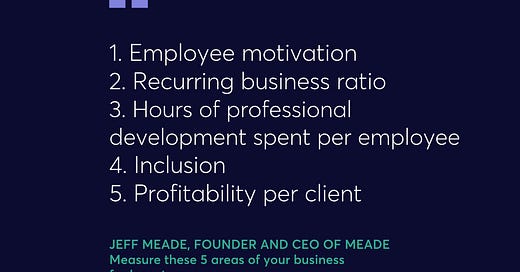Measure these 5 areas of your business for long-term success
The pandemic put many businesses on the defensive, with agency leaders spending most of the last two years focused on protecting critical business functions. Now, it's time to go back on offense. In this article previously published in Entrepreneurs Organization (EO), I map out an offensive strategy for this year and beyond, discuss the five "nonnegotiables" you should include in your growth plan, and explain how each nonnegotiable serves the big-picture objectives of your business.
1. Employee motivation
I’m going to state the obvious: Motivating remote teams was/is hard. When people aren’t physically around each other, they can lose their sense of purpose. (If you’re not sure how detached your staffers are, Vega Factor has a survey you can use to measure engagement.) Consequently, you need to make sure your employees know they are valuable because they help your organization innovate. How can you rev up motivation? Remind everyone about your organization’s BHAG (short for “Big Hairy Audacious Goal”). Be explicit about how they contribute to meeting the BHAG. Seeing the road ahead gives everyone on your team a long-term perspective beyond today’s responsibilities.
2. Recurring business ratio
As part of your planning and scorecard process, define your revenue floor. Figure out what percentage of your revenue will recur next year without any effort. The amount you come up with should be based on legacy data unless you’re involved in a startup. Even if you’re the leader of a newer business, you may still be able to come up with a revenue floor figure. Calculating your recurring business ratio will show you how much money you can put into strategic investments. It will also give you an idea of how far away or near to your annual projections you already are.
3. Hours of professional development spent per employee
Workers who aren’t continuously up-skilled risk personal and professional stagnation. They’re also more likely to leave for greener pastures. So keep track of how many hours of professional development you give each team member. Ideally, the number should move up incrementally year after year.
Not sure what types of workshops, classes, or certifications your employees need? Give them a say in the matter. Generate an individual development plan (IDP) for each person. The IDP will be crafted by both the team member and team supervisor, answering questions such as “Where do I want to be?” and “How can I get to my next professional level?” Monthly check-ins can ensure that IDPs are being followed throughout the year.
4. Inclusion
Building a sustainable, long-term organization where people are comfortable bringing their whole selves (and ideas) to work requires an inclusive environment. At our company, I use ranked method surveys to track inclusivity progression over time for clients. For example, I’ll send out surveys and ask employees to rate answers based on a scale of one to five. Some of my favorite survey inquiries include: “I belong here,” “I believe management respects everyone equally,” and “I can express my opinion here without repercussion.” Allowing everyone to quantify their feelings highlights potential problem areas, giving us places to improve inclusivity at the workplace.
5. Profitability per client
The final must-have item on your business scorecard is per-client profitability. This involves seeing each client alone, not just as part of your client roster. Why? Quite frankly, you don’t want to pay for the privilege of having a client. That’s not good for your revenue. The simplest way to figure out per-client profitability is to look at per-client gross profit, which is per-client revenue minus the costs of goods sold. You may be surprised at the clients that aren’t profitable for your business — and are draining your resources.
The past two years might have been the toughest of your career. Nevertheless, you can get your agency business back into high gear. Simply pay attention to your metrics, keep a handle on your scorecard, and help everyone on your team move together toward collective success.
I'm running an experiment and you're part of it :)
I want to know what it looks like when an email list is built almost entirely on referrals. A list where agency leaders join because someone (you) tells them that my emails are helpful.
If you're getting something out of my emails, please share with your network when/where appropriate.





